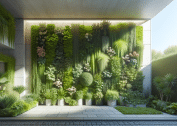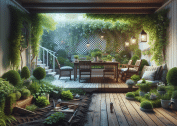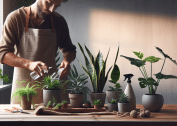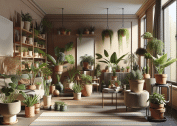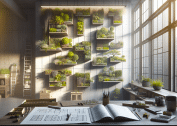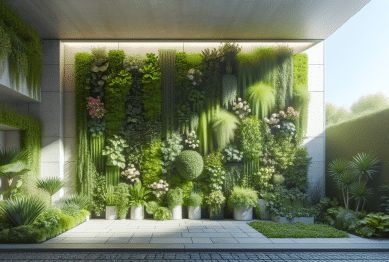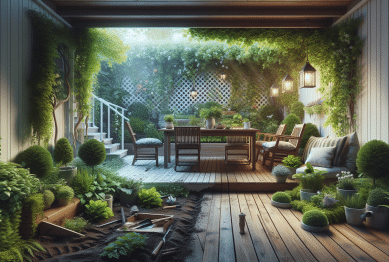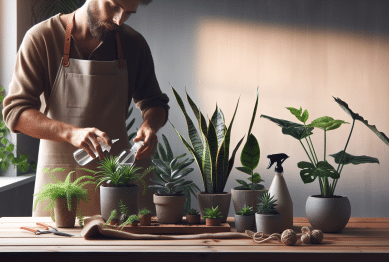In 2025, interior design is experiencing a shift toward spaces that are not only visually appealing but also deeply personal, emotionally resonant, and reflective of individual identity. The focus has moved from following generic trends to creating homes that tell a story—your story. Homeowners and designers alike are exploring ways to create interiors that feel authentic, engaging, and uniquely expressive.
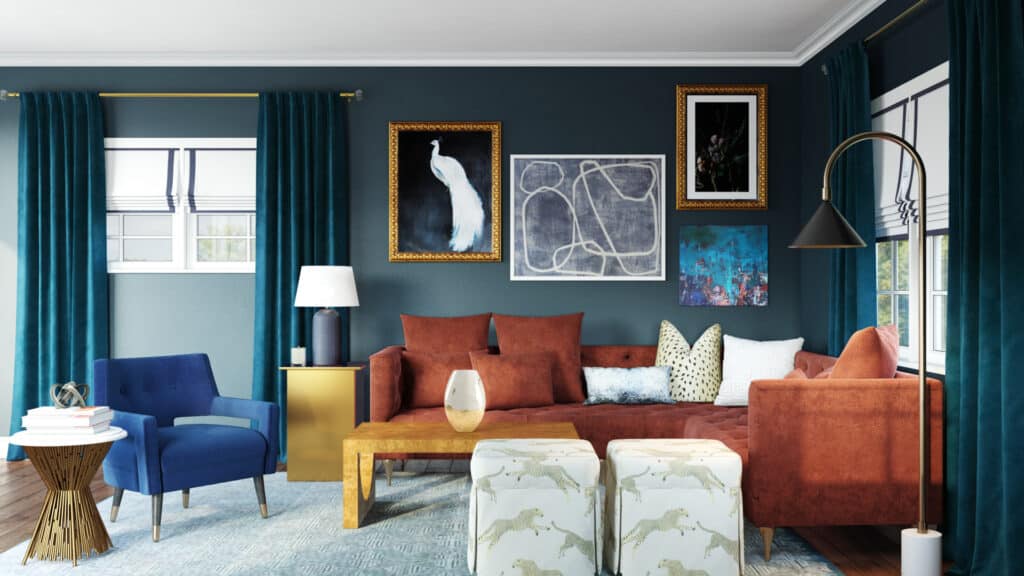
The Shift Towards Personalized Interiors
Traditional design often emphasized uniformity and mass appeal, but today, personalization is at the forefront. People are no longer content with spaces that look good but lack character. The desire to create interiors that communicate identity has been fueled by several key factors:
- Increased Time at Home: Remote work and lifestyle changes have made the home a central space for both living and working. This shift has made comfort, functionality, and emotional resonance more important than ever. Homeowners are seeking spaces that nurture well-being and reflect personal priorities.
- Authenticity and Individuality: In an era dominated by mass-produced furniture and generic styles, individuality in design is increasingly valued. Homeowners are prioritizing unique pieces, bespoke furniture, and personal accents to distinguish their homes from others.
- Emotional Connection: Homes are becoming expressions of identity, filled with meaningful objects and designs that evoke memories, experiences, and passions. The emotional impact of a space is now as important as its visual appeal.
- Experiential Design: People want their homes to provide experiences, not just aesthetics. Thoughtfully designed interiors can create moods, stimulate the senses, and inspire creativity.
Key Trends Defining Personalized Interiors in 2025
1. Victorian Revival with a Modern Twist
A resurgence of Victorian-inspired interiors is shaping the way personality is expressed in 2025. This revival incorporates ornate moldings, rich fabrics like velvet and silk, and jewel-toned palettes, blending historical elegance with contemporary sensibilities. Homeowners can embrace elements of opulence, such as intricate woodwork, chandeliers, and luxurious draperies, while integrating modern furniture and lighting to maintain balance. This trend allows individuals to express a love for history while infusing spaces with personal style.
2. Pattern Drenching
Pattern drenching is a bold design trend that envelops entire rooms in coordinated prints across walls, furniture, textiles, and accessories. This approach enables homeowners to craft highly expressive, dynamic interiors that reflect their personality. Combining patterns from different eras, cultures, and materials can result in spaces that feel vibrant, eclectic, and intentionally curated. From floral wallpapers to geometric designs and textured fabrics, pattern drenching emphasizes individuality and creativity in interior design.
3. Earthborn Elegance
Nature-inspired interiors are gaining traction as people seek grounded, authentic spaces. Using raw and organic materials such as wood, stone, clay, and natural fibers, designers create a tactile connection to the environment. Earthborn elegance emphasizes warmth and texture, allowing homeowners to reflect personal values such as sustainability and mindfulness. This trend also enhances the sensory experience of a home, promoting comfort and tranquility while allowing personal style to shine through.
4. Soft-to-Touch Textures
Comfort and tactile richness are defining features of 2025 interiors. Homeowners are layering soft, luxurious fabrics such as bouclé, velvet, and plush textiles to make rooms feel inviting and cozy. Combining tactile materials with color, lighting, and furniture design allows for a multi-sensory experience that reflects both personality and lifestyle. These choices enhance the emotional quality of a space, creating an environment that feels warm, approachable, and personalized.
5. Emotional Architecture and Wellness Features
Homes are increasingly designed as sanctuaries that support mental and physical health. Emotional architecture integrates sensory elements like circadian lighting, acoustic treatments, aroma diffusion, and spatial organization to enhance well-being. This trend also prioritizes functionality, with meditation corners, reading nooks, and wellness areas integrated seamlessly into living spaces. By considering how design affects mood, homeowners can create spaces that nurture both body and mind while reflecting personal priorities.
6. Multi-Functional Spaces
With the rise of remote work and flexible lifestyles, multi-functional rooms are more important than ever. Personalized interiors of 2025 often include spaces that adapt to changing needs, such as home offices that double as guest rooms or hobby areas that transform into meditation zones. Flexible layouts enable homeowners to express their lifestyle and personality while maintaining practical functionality. Movable furniture, modular storage, and room dividers are common features that allow for versatility.
7. Statement Lighting and Custom Fixtures
Lighting is no longer just functional; it has become a tool for self-expression. Designers are using statement chandeliers, sculptural lamps, and customizable LED installations to create focal points and reflect personal taste. Lighting can dramatically influence the mood of a room, highlighting textures, colors, and key design features while reinforcing the homeowner’s style. Personalized lighting solutions also allow for the creation of unique atmospheres that resonate with individual preferences.
Practical Tips for Designing a Home That Reflects Your Personality
Creating interiors that truly reflect your personality involves more than following trends. Here are actionable strategies to personalize your home in 2025:
- Define Your Color Palette: Choose colors that evoke the emotions you want to feel at home. Warm tones like caramel, terracotta, and muted gold create comfort and grounding, while cool tones can inspire calm and focus.
- Curate Personal Artifacts: Display items with meaning—family heirlooms, travel souvenirs, artworks, and handcrafted objects. These elements tell your story and add authenticity to your interiors.
- Mix Textures and Patterns: Layering textures and combining patterns creates depth and interest. Don’t shy away from bold contrasts or unexpected pairings; they make your space unique and reflective of your tastes.
- Invest in Statement Pieces: High-quality, meaningful furniture and décor can elevate a room and convey personality. Choose pieces that resonate with your style, whether through design, craftsmanship, or storytelling.
- Create Functional Zones: Designate areas for reading, relaxation, hobbies, or socializing. Personalizing these spaces based on your lifestyle enhances comfort and ensures your home reflects who you are.
- Incorporate Nature: Plants, natural light, and organic materials foster a sense of balance and connection. A home that incorporates elements from nature can feel both inviting and reflective of values like sustainability and mindfulness.
- Experiment with Artistic Expression: Use murals, wall art, or sculptural pieces to reflect your creativity. Artistic elements give personality to blank walls and become conversation starters.
- Consider Scale and Proportion: Personalization isn’t just about color or objects—it’s also about space and layout. Tailor room proportions, furniture sizes, and circulation paths to suit your needs and aesthetic preferences.
- Embrace Sensory Design: Incorporate scents, textures, and soundscapes that appeal to you. Elements like soft textiles, fragrant candles, or background music systems can make your home feel immersive and personalized.
The Future of Personalized Interiors
The personalization trend is expected to evolve alongside technological advancements and sustainability initiatives. Smart home features will integrate more seamlessly with design, adapting lighting, temperature, and ambience to your needs. Sustainability will play a key role, with eco-friendly materials, energy-efficient systems, and local craftsmanship becoming central to how personality is expressed in design. The future of interior design will be less about generic aesthetics and more about creating spaces that reflect identity, nurture well-being, and promote conscious living.
Designing interiors that reflect personality is no longer optional—it is becoming essential. The spaces we inhabit are extensions of ourselves, offering opportunities to express identity, cultivate comfort, and foster emotional connections. By embracing these 2025 trends and personalizing your home thoughtfully, you can create a living environment that is both functional and deeply reflective of who you are.
References
- House Beautiful. (2025). Colors that make your home look expensive. Available at: https://www.housebeautiful.com (Accessed: 18 August 2025).
- Who What Wear. (2025). Home decor trends 2025: Interior design ideas to refresh your space. Available at: https://www.whowhatwear.com (Accessed: 18 August 2025).
- Daily Telegraph. (2025). Rise of emotional architecture and wellness in homes. Available at: https://www.dailytelegraph.com.au (Accessed: 18 August 2025).


